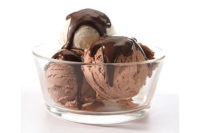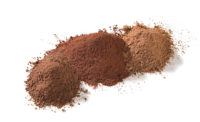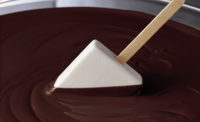Chocolate and cocoa pair well with dairy products
Chocolate and cocoa are long-time associates of dairy. These days, everything from frozen yogurt to blended coffee beverages is angling for a chocolaty profile. A panel of experts explains how to formulate with the ingredients.






Dairy Foods: In frozen dairy, how do textural, processing and storage considerations affect what kind of chocolate or cocoa inclusions to use?
Reed: Standard-of-identity chocolate is not typically found in hard-packed or soft-serve ice cream, because when chocolate is cooled to these temperatures, it becomes extremely hard to bite. Chocolate melts at body temperature. Chocolate eaten frozen doesn’t readily melt in the mouth and has the potential to chip the consumer’s teeth.
One way to get chocolate into ice cream is to melt it down and add oils such as coconut and soybean blends with a much lower melting point than cocoa butter, and then mold it back into an ice cream compound inclusion like chunks, chips and flakes. Although this product would not meet the standard of identity for chocolate, it would still provide the consumer a chocolate flavor profile. It also allows for the term “made with chocolate” to be added to the product label.
Pimpo: Low-melt products work much better in hard-packed or retail ice cream. We formulate our inclusions to melt at 60°F, which provides for a much better mouthfeel. Low-melt products can be used in soft-serve applications and the now popular buy-by-the-ounce yogurt shops, but you will need a cooler table to ensure the products keep their integrity. Without that, shelf-stable chocolates can be used. And since the consumer will be eating the product immediately — and it is not being frozen — you will achieve the anticipated melt and mouthfeel.
Dairy Foods: What’s the key to designing chocolate-enrobed coatings for frozen dairy?
Widlak: Enrobed coatings face the same challenges as inclusions, and the solutions are similar. Cocoa butter in chocolate has quick-solidifying properties, referred to as “drying,” and a quick-drying coating is preferred to a coating with slow-drying properties. But cocoa butter is very brittle at frozen dairy temperatures. Upon consumption, thicker chocolate coatings break off in large chunks, making the frozen dairy product difficult to consume.
To reduce the solids that impart the brittle properties, coating manufacturers will add a vegetable oil to the chocolate coating, make a coating using a lower melt-point fat with quick-drying properties, like coconut oil, or use a combination of fats to deliver a coating that solidifies, dries quickly and has sufficient solids to provide a bite or snap upon consumption, but also is pliable so it is not too brittle.
Dairy Foods:What inclusion and variegate innovations have widened the variety of “fun stuff” we can mix into frozen dairy products?
Reed:Under the Wilbur Chocolate brand, Cargill Cocoa & Chocolate offers a milk and dark ice cream coating, both made with vanilla, and a #95 flake with a strong dark-chocolate flavor. Ice cream products are also available from the Peter’s Chocolate product line.
Pimpo: According to a recent article, the No. 1 ice cream trend for 2012 is peanut butter. Gertrude Hawk’s most recent innovation for the ice cream/dessert industry is a low-melt cut peanut butter cup.
Recent innovations to match culinary dessert trends include our caramel sea salt truffles, espresso chips and milk pretzel nibs.
Dairy Foods: Dairy is famous for its healthy halo; increasingly, so is chocolate. Any comments on how bringing the two together can give chocolaty decadence a good-for-you name?
Reed: Increasingly, dark chocolate has received positive press about potential health benefits associated with its consumption, since it is made with higher cocoa solids, which contain antioxidants. As a result, dark chocolate can be paired with dairy products to create an indulgent formulation with marketable health claims. In addition, cocoa powder is being used in protein shakes and protein powder mixes. It provides a great chocolate taste without adding additional cocoa butter fat and sugar to the product.
Stunek: We have certainly done quite a bit of work with sports recovery products and fortified dairy beverages. Chocolate is a great vehicle for that because so many people love it, it can mask the unwanted tastes of other nutritional ingredients and it blends so well with other flavors.
Widlak: Diets enriched with cocoa flavanols have been demonstrated to increase levels of beneficial bifidobacteria in the gut, suggesting that benefits on human health from this association could be realized, although that has yet to be proven definitively. Both Mars and Nestle are sponsoring extensive research in this area. [See related article on page 46.]
Looking for a reprint of this article?
From high-res PDFs to custom plaques, order your copy today!









